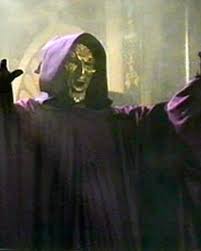
The Doctor and Sarah Jane explore the new TARDIS (The original having fallen apart during filming of the previous story) and discover an alternate control room with wood panelling and brass rails like a gentlemen’s club—more suitable to Tom Baker than the stark white room of the original. The TARDIS is temporarily caught by the Mandragora Helix, a spiral of energy, able to control the time-ship. Under its influence, the travellers arrive at the Dukedom of San Martino in Renaissance Italy, where the Mandragora energy is let loose. The energy penetrates an underground temple and appears to the secret and long-outlawed Brotherhood of Demnos, whose leader the astrologer Hieronymous (Norman Jones) is told to prepare for Mandragora’s full appearance.
Hieronymous is being used by Count Federico (John Laurimore) to stop his young nephew Giuliano (Gareth Armstrong) from mounting the throne on his father’s death, which was predicted and probably arranged by Hieronymous. The accession is to be celebrated with a masque. Many scholars are coming to the celebration, including Leonardo da Vinci and the Duke of Milan, whom the Doctor does not wish to see endangered.
Sarah is kidnapped and threatened, of course, with human sacrifice. The Doctor warns Count Federico of the danger of the Mandragora but is not believed and is scheduled to be beheaded. With a great deal of trick-riding and swordplay, the Doctor escapes and sets out to save Sarah. The Helix interrupts the sacrifice by its arrival, and the Doctor spirits Sarah Jane away. Now the Brotherhood worships the Helix, and Hieronymous is to be the supreme ruler of Earth.
During the ball, the Demnos Brethren attack the court and kill many guests. Hieronymous, now completely at one with the Mandragora, confronts the Doctor in the subterranean temple and tries to blast him with energy. The Doctor, however, has grounded himself and the altar, so the energy drains away, saving the planet—until the constellations are once again in the correct configuration to release the Helix, at the end of the 20th Century.
The story was partially filmed in the Welsh tourist village of Portmeirion, which was built by Sir Clough Williams-Ellis in the 20’s, based on the Italian town of Portofino. Various stairways and passages may be familiar from the British TV series The Prisoner with Patrick McGoohan. Some of the costumes came from Franco Zeffirelli’s 1968 Romeo and Juliet, and before that, Renato Castellani’s 1954 version. Reviewers were reminded of Roger Corman’s film Masque of the Red Death and Machiavelli’s play The Prince and the Mandragola, with a little bit of Hamlet thrown in. There was so much horse-wrangling and sword-fighting in the story that they had to hire a bunch of stuntmen. They all smoked. Since there were no pockets in their Renaissance clothing, they kept their cigarettes in their codpieces.
Part 1
Part 2
Part 3
Part 4
